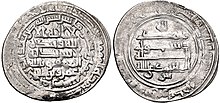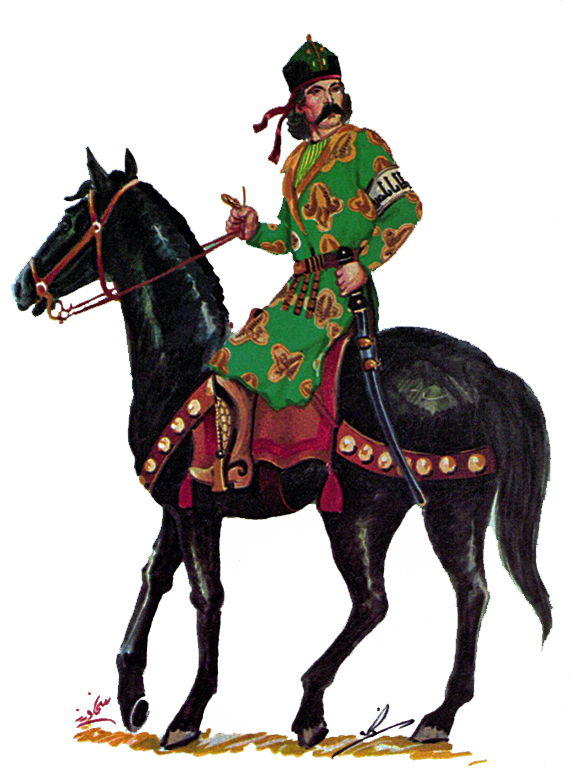Saffarids
The Saffarids (Persian صفاریان, DMG Ṣaffāriyān) were a Persian-born , Muslim dynasty from 861 until they are disposed by the Ghaznavids the 1003 Iranian region of Sistan with capital Zarandsch dominated and (still her Tahirids and after her Samaniden ) temporarily rose to the dominant power of the Islamic East by conquering the whole of Khorasan and advancing into Iraq and India . Due to the Samanids taking over power at the beginning of the 10th century, the dynasty divided into the two lines of the Laithids (Laiidenids) and Chalafids (Ḫalafids). The rulers who ruled Sistan from 1030 are sometimes also referred to as (descendants of) the Saffarids, but there is no verifiable connection between these so-called rulers of Nimruz and the "real" Saffarids.
history
Abu Yusuf Yaqub ibn al-Laith as-Saffar
The rapid rise of the dynasty began in Sistan at a time of general uncertainty; H. constant fights between the governors of the caliph , rebellious peasants, local rulers such as the Tahirids, the Kharijites sect, bands of religious warriors, tribal leaders and simple vigilantes .
The adventurer Yaqub ibn al-Laith (r. 861–879), called as-Saffar (the coppersmith ), was originally a mercenary of the governor of Bost , Salih b. an-Nadr (from 852 Emir, † 865), who rebelled against the Tahirids around 854 and ousted their governor from Saranj . In an opaque process, the governor himself was defeated by a rival named Dirham b. Nasr (from 858 emir in Saranj) ousted, and this then by Yaqub, who was now elected emir (861). After a bitter skirmish with the garrison and a leader called " Zunbil " (called by Salih b. An-Nadr) , he captured Bost (865).
Then Yaqub defeated neighboring leaders, specifically a Kharijite leader named Ammar b. Yasir 865 and "Zunbils" son Firuz b. Kabk 869. The latter fled to the Hindu Shahi in Kabul , whereupon Yaqub conquered the city and also took Firuz prisoner
. The caliph received part of the booty from the sacking of Kabul, fifty idols made of gold and silver, which he sent on to Mecca . Other targets in this campaign of 869/70 were Da'ud b. al-Abbas of Balch and Abu Mansur Aflah of Gardiz .
In the course of his endeavors, Yaqub formed a tightly organized military power out of eastern Iranian militia groups and other armed groups. Probably behind his large army and its need for money there was also a corresponding tax collection in the conquered areas, about which little is known. A lawsuit (before the caliph) from Tabaristan in 874 is known. On the other hand, however, it is also alleged (in Tarich-i Sistan) that Yaqub listened to complaints concerning himself and that the particularly poor were spared his taxes.
Overthrow of the Tahirids and advance against the caliph
Parallel to securing his rule in Sistan and today's Afghanistan , he expanded to Kerman and Fars (around 869) and on to Khorasan ( Herat , 867-71). This happened mainly at the expense of the Tahirids , but also at the expense of local Kharijite leaders and the caliph's governors. In Fars, for example, Ali b sat. al-Husain, and the caliph hoped to pit the ambitious figures Ali and Yaqub against each other by sending both certificates of appointment for the province of Kerman, which actually belonged to the Tahirids. But Ali was defeated by Yaqub and taken prisoner in Shiraz (869).
Yaqub overthrew the Tahirids in 873 with the occupation of Nishapur and the capture of the Emir Muhammad (r. 862–73, † approx. 890). But Transoxania , which also belongs to the Tahirids, could not be subjugated, since the previous Samanid governors had already established themselves there with the support of the caliph.
The growing power of the Saffarids worried the caliph al-Mu'tamid (870-892) and he declared Yaqub 874 to be a usurper . But at the same time he fought the uprising of the Zanj and the Aliden in Kufa and Medina, which gave Yaqub a lot of freedom of action. When al-Mu'tamid's new governor fell victim to a rebellion in the (for him vitally important) province of Fars , Yaqub moved there to defend the rebel Muhammad b. Fought Wasil in the name of the caliph and appropriated the province (875). After Yaqub also occupied Wasit , despite an undignified U-turn by the caliph (certificates of appointment for all conquests, mention in the Chutba in Mecca and Medina) , al-Mu'tamid (or his regent al-Muwaffaq) only had a military solution.
Yaqub advanced to Baghdad and suffered his first major defeat at Dair al-Aquh (on the Tigris, near Baghdad) in 876. He withdrew and died of fever in Djondi Shapur in 879, while former followers rose in Khorasan.
Abu Hafs Amr ibn al-Laith

Yaqub's brother and successor Amr ibn al-Laith (ruled 879-900, a former mule keeper or stonemason) continued to rule Sistan, Khorasan and Fars and was recognized by the caliph as governor of the territories conquered by Yaqub in return for payment of one million dirhams . Nevertheless, he was only able to consolidate the empire with difficulty against a number of newly emerging rivals (in Khorasan e.g. Abdullah Chudschistani, Abu Talha Mansur b. Sharkab, Rafi b. Harthama). He had to z. B. flee from Khujistani's troops from Nishapur to Herat in 880 and a little later shared control of Khorasan with Abu Talha. The Samanids in particular benefited from these disputes , who intervened twice in 885 in favor of their rivals. Likewise, al-Muwaffaq (the brother and regent of the caliph) was able to briefly conquer the province of Fars 884-87 before he had to make peace because of other problems ( Tulunids , Byzantines ). In 883 Amr was confirmed as governor against payment of four million, and in 888/9 against ten million dirhams. In 896 it was again four million dirhams.
After getting rid of his rivals, Amr interfered in the internal affairs of Khorezm and met with resistance from the Samanids, who considered the area their domain. In 898 Amr was declared governor in Transoxania by the caliph al-Mu'tadid bi-'llah (892-902) and began a war against the Samanids. After heavy fighting with Ismail I (r. 892–907), Amr ibn al-Laith was defeated at Balch and taken as a prisoner to Baghdad (900), where he was murdered two years later. Then Ismail Khorasan took over and was granted areas by the Caliph Amrs.
Under the early Saffarids, the Islamization of eastern Iran and today's Afghanistan was intensified, as these areas were so far strongly influenced by Buddhism and Hinduism . Specifically, this means, for example, that Amr ibn al-Laith's officer Fardaghan sacked the Hindu temples in the Logar Valley near Kabul and thereby provoked a counter-attack by the Hindu Shahi under Kamaluka on Ghazna . This time too the caliph got his share of the booty (896).
The late Laithids and the Chalafids
The Saffarids only lasted for a long time in Sistan and some neighboring areas, with the Saranj residence in Nimruz . The new Emir Abu l-Hasan Tahir ibn Muhammad ibn Amr (r. 900–909) was a weak ruler who spent his time hunting and spending a lot of money on his gardens and palaces. In order not to be considered a tyrant, he did not collect taxes. After six years, Tahir had completely used up the fortune of at least 36 million dirhams he had taken over from his predecessor. He was deposed by his uncle (2nd degree), Al-Laith ibn Ali, the governor at the time in Kirman and Makran, and fled to Sebükeri (Subkari), his commander in Fars , who took over his remaining followers and handed him over to the caliph. Al-Laith ibn Ali (ruled 909-10) then took action against Sebükeri, but was defeated (with the support of the caliph), captured and also extradited.
Al-Laith's brother and successor Muhammad b. Ali (ruled 910) only ruled in Sistan, Zamindavar and Zabulistan . He was betrayed by his brother al-Muaddal, defeated by the Samanid Ahmad II (r. 907-914) and, like his three predecessors, handed over to the caliph.
A revolt in the name of a ten-year-old Saffarid prince named Abu Hafs Amr failed in 912/3, so that the rule of the Saffarids was only re-established by Abu Dschafar Ahmad ibn Muhammad ibn Chalaf (r. 923-963), who was only a distant relative of the previous rulers was. His grandfather Chalaf was a follower of the two founders of the dynasty. Ahmad asserted himself against the claims of the caliph al-Muqtadir (r. 908-932) and rival Saffarid prince, achieved great prestige at times and was murdered in 963.

His son and successor Wali d-Daula Abu Ahmad Chalaf (r. 963-1003) initially shared power with a former general of the Samanids, Abu l-Husain Tahir (d. 970), who was also a Saffarid on his mother's side. Between 964 and 969, Chalaf was on a pilgrimage to Mecca, so Tahir ruled alone and then refused to relinquish power. The erupting conflict between Chalaf on the one hand and Tahir or his son Husain on the other hand lasted until 983 and was complicated by the military interference of the Samanids and (their semi-independent vassals) Sebük Tigin . After all, Chalaf was so unpopular due to despotic inclinations that the army leadership and residents of Saranj took part in his overthrow when Mahmud of Ghazna (r. 998-1030) conquered Sistan and put an end to the Saffarid rule.
Nasrids and Mihrabanids
In some representations, the Nasrids (1030–1225) and Mihrabanids (1236– approx. 1542) who later ruled Sistan are also assigned to the Saffarids. However, from earlier works on the history of Sistan, such as the Tarich-i Sistan and Malik-Shah Husain's Ihya al-muluk , it emerges that these two rulers are neither related to each other nor to the first two Saffarid lines.
See also
Remarks
- ↑ Zunbil was the name of a dynasty in Zamindavar and Zabulistan, which was allied with the Hindu Shahi and which can possibly be traced back to the Hephthalite kings of Zabul. The real name of the Zunbil leader was probably Kabk.
- ^ RN Frye, William Bayne Fisher, Ilya Gershevitch, Ehsan Yar Shater (eds.), The Cambridge History of Iran, Volume 4
literature
- Clifford Edmund Bosworth: Chapter "The Ṭāhirids and the Ṣaffārids" in: The Cambridge History of Iran, Vol. 4 - The Period from the Arab Invasion to the Saljuqs , ed. By RN Frye, Cambridge 1975
- Clifford Edmund Bosworth: The History of the Saffarids of Sistan and the Maliks of Nimruz , Costa Mesa CA / New York, 1994
- Clifford Edmund Bosworth: Article “Saffarids” (June 8, 2010) in: Encyclopaedia Iranica , Online Edition


